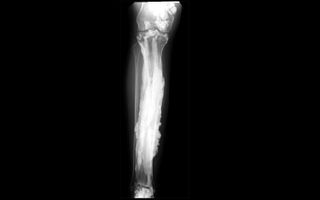Here's What Causes Some People's Bones to 'Drip' Like Candle Wax

A rare and puzzling condition called "dripping candle wax" bone disease just got a little less mysterious.
In a new study, scientists say they've found a genetic mutation that appears to cause the disease, which results in excess bone formation and makes people's bones appear to drip or flow like candle wax on X-rays.
The findings not only suggest new ways to treat the condition but also provide clues about normal bone development, and could have implications for more common bone conditions, including osteoporosis, the researchers said.
The study was published today (April 11) in the journal Nature Communications.
Only 400 cases of "dripping candle wax" bone disease, formally known as melorheostosis, have ever been reported. In people with this condition, areas of bone become overly thick and dense, leading to symptoms such as pain, limited range of movement and limb deformities, according to the National Institutes of Health. The condition usually affects just one part of the body — often a lower limb — but in rare cases, it can affect multiple areas. [11 Surprising Facts About the Skeletal System]
There is no cure for the condition, and treatments are aimed at improving people's symptoms. Treatments may include physical therapy, surgery or medications that affect the bone remodeling process, according to the National Organization for Rare Disorders (NORD). But no single treatment has been found to be fully effective in all patients, NORD said.
The new study analyzed biopsies from 15 people with the condition. Researchers took samples of healthy (unaffected) bone and affected bone from each participant, and they looked for genetic differences between the samples.
Sign up for the Live Science daily newsletter now
Get the world’s most fascinating discoveries delivered straight to your inbox.
They found that eight of the 15 participants had genetic mutations in a gene called MAP2K1. These mutations were found only in affected bones, not in healthy ones.
"Scientists previously assumed that the genetic mutations responsible for melorheostosis occurred in all cells of a person with the disorder," co-senior study author Dr. Timothy Bhattacharyya, head of the Clinical and Investigative Orthopedics Surgery Unit at the National Institute of Arthritis and Musculoskeletal and Skin Diseases, said in a statement. But the new findings show that the mutations are only in affected tissues, he said.
The MAP2K1 gene has previously been linked to some types of cancerous growths. The new study found that the MAP2K1 mutations caused a protein called MEK1 to become overactive. Finding ways to inhibit MEK1 activity may provide a new way to treat the disease, the researchers said.
What's more, future studies on how the MAP2K1 pathway works in both normal and abnormal bones may have implications for a wide population, the researchers said. For example, "most adults have the problem of weakening bones as they grow older," which is the opposite of what happens with melorheostosis, Bhattacharyya said. "The prospect that we could somehow harness this pathway in the future is so exciting," he added.
Original article on Live Science.

Rachael is a Live Science contributor, and was a former channel editor and senior writer for Live Science between 2010 and 2022. She has a master's degree in journalism from New York University's Science, Health and Environmental Reporting Program. She also holds a B.S. in molecular biology and an M.S. in biology from the University of California, San Diego. Her work has appeared in Scienceline, The Washington Post and Scientific American.

